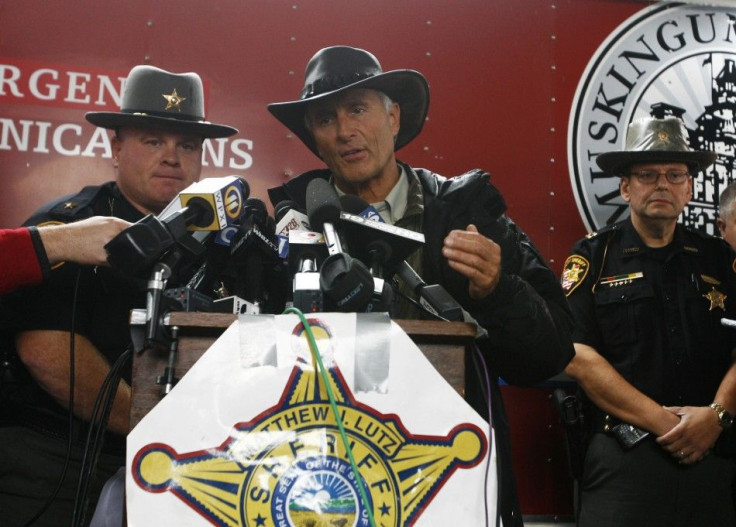Ohio Zoo Animals Not for Sale: What Will They do With the Remains?

Dozens of exotic animals in Ohio put down by authorities are now being sought out by entrepreneurial hopefuls looking to turn the wild game into profitable taxidermy pieces.
Nearly 50 tigers, lions, bears and other large exotic animals were killed after they escaped from Terry Thompson's Muskingum County Animal Farm in Zanesville, Ohio, earlier this week. Thompson apparently released the animals from their cages before shooting himself on the property. By Wednesday, 49 of the 50 animals were confirmed dead -- most put down by sheriff's deputies -- and the remaining missing animal is believed to have been killed by another escaped animal.
We've gotten calls and e-mails about what [is] going to happen to the animals ... could they be obtained for these types of things, Muskingum County Sheriff Matt Lutz told ABC News. There's a lot of people who would pay a lot of money to get these animals.
Federal law prohibits the sale of the animals, according to Frank Zitz, a New York-based taxidermist and expert on exotic and endangered species.
Theoretically, that tiger could be gifted to someone in Ohio, Zitz told IBTimes. But it cannot be exchanged for money, and a tiger's skin cannot go outside the state of Ohio.
Once you step across the state line with one of those cats, it's a violation of the Lacey Act, (a federal act which regulates the trafficking of illegal wildlife). Unauthorized transportation of an exotic animal is basically the same thing as trafficking drugs, Zitz said.
It is not entirely clear where Thompson obtained all of his animals, or how he managed to feed them. The Associated Press obtained court records showing that Thompson owed $68,000 in back taxes.
I've heard that some were rescues, Lutz told ABC. I've heard that some were bought at auction.
Zitz said that a tiger can eat up to 30 lbs. of meat a day.
He really had more there than what he could do, Kenny Hetrick, a fellow exotic animal owner who knew Thompson from auctions in Ohio, told The Associated Press. I don't know what his deal was, but he was in over his head.
While acknowledging that his own impression is based on educated speculation, Zitz agreed with the assessment that Thompson could have cracked under the pressure of maintaining his private zoo, and/or pressure to find a new home for the animals.
If he was being pressured by authorities to get rid of those animals, he could have been overwhelmed, Zitz said, explaining that certain species of animals cannot cohabitate with unfamiliar members of the same species -- which makes it extremely difficult to place the animals at a facility that could properly care for them.
Lions are pride animals, Zitz said You can't just put them together like you can two rabbits.
Lions cannot be expected to welcome a strange newcomer into their environment without conflict, Zitz explained. In the wild, when a male pride leader becomes weakened by age, a new, stronger lion will come into the pride and kill all the cubs before mating with the female lion, ensuring the pride possesses only his lineage.
And that's not the only problem with relocating the types of animals Thompson kept.
Those big cats, they are a real liability to transport, Zitz continued. What if you get into an accident and the truck flips over? I don't think people are aware of how dangerous they are.
On that point, Zitz expressed agreement with law enforcement's decision not to attempt to tranquilize the animals at night. He took it even further, explaining that it would be unrealistic to expect to be able to safely tranquilize a large cat under any circumstances.
A lion is ten times faster than an attack dog, Zitz said. If someone is close enough to a lion to hit it with a tranquilizer gun, they are close enough to be gravely injured or killed in the process.
If a lion was fifty feet away from you it would take him two seconds to get on top of you, Zitz said.
I don't think they could have handled it any other way, Zitz said of the decision to kill the animals. It's absolutely tragic that [Thompson] did that to those animals, he said, adding that he felt Thompson had to have known the animals had no chance of surviving once they were released from their cages.
That guy must have been in some trouble, Zitz said. Even though I work in taxidermy, I really feel for those animals.
So what should happen to the 49 animals who died as a result of Thompson's actions?
I think the idea that they just bury them all is kind of ridiculous, Zitz said, while acknowledging that the carcasses might not be of much value to museums because there is so little known about their origins and background.
I can't believe there aren't some schools some educational facilities in the area that could benefit from having those animals as educational tools, Zitz said. There's something to be learned from all this.
© Copyright IBTimes 2024. All rights reserved.








